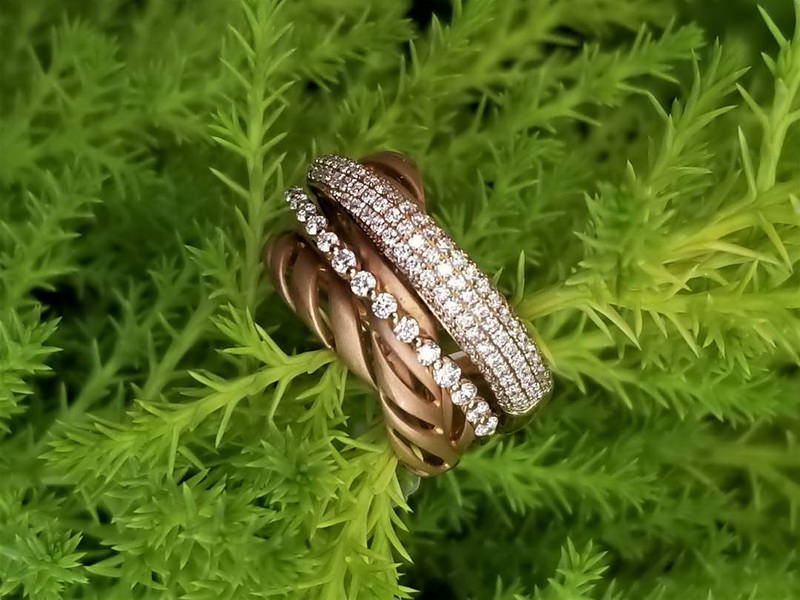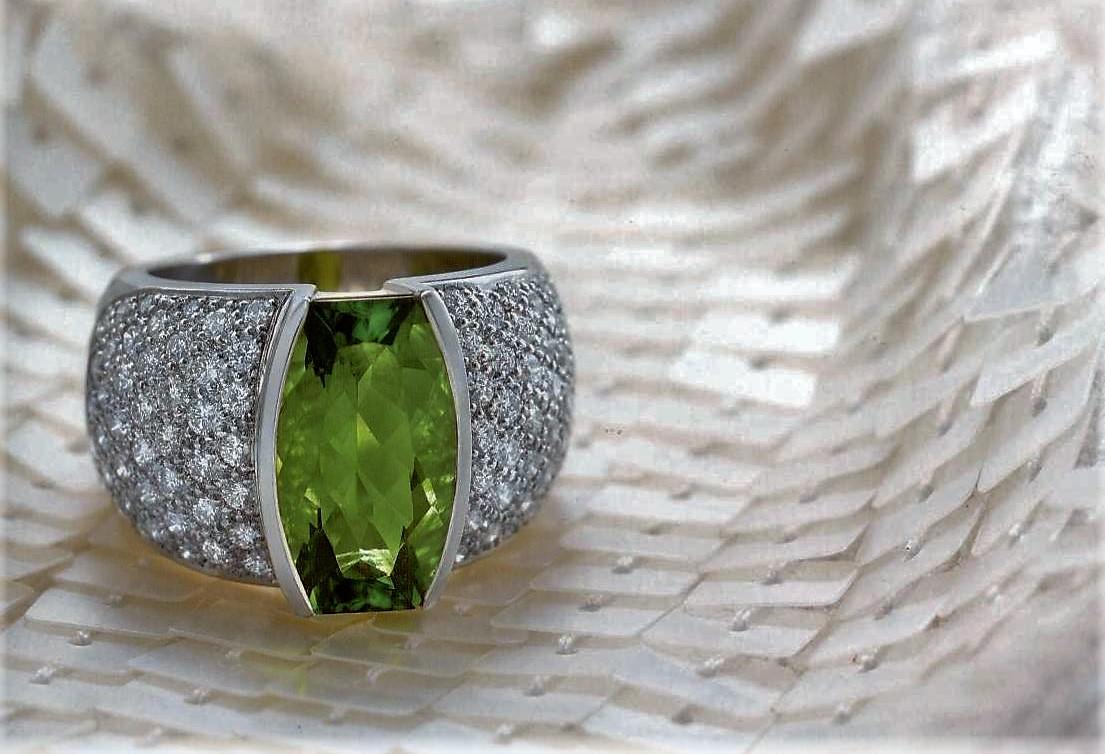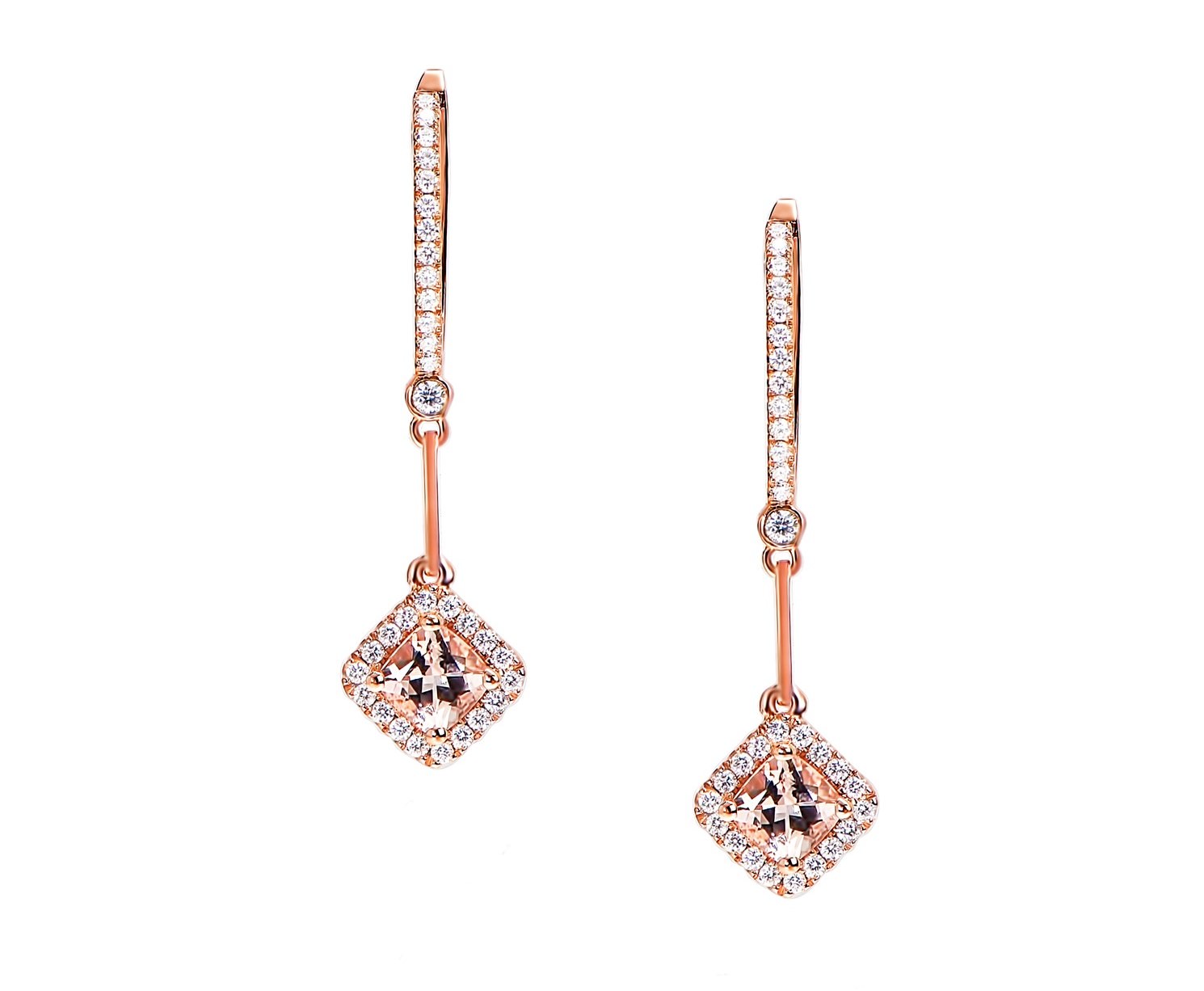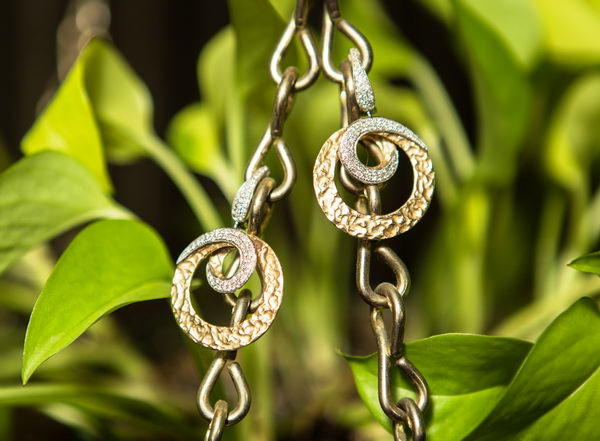-
GOLD
Since the beginning of recorded human history, gold has signified wealth, symbolized achievement and been treasured for its natural beauty and radiance; the earliest known gold artifacts date to the 4th millennium BC. So it naturally follows that gold evolved to be the classic choice for high-value jewellery. It is a remarkably versatile, beautiful and durable metal for rings, earrings, bracelets, necklaces and objet d'art. Gold has wide appeal and is popular and attractive to both men and women because of its lustre and colour varieties, at least one of which will complement virtually any skin tone. For engagement rings, wedding bands and jewels celebrating the deeper emotional occasions gold is unaffected by time making it the traditional symbol of enduring love.
Purity and Fineness
Pure gold is a bright slightly reddish-yellow metal weighed and measured in troy ounces. One troy ounce is 31.1034768 grams. The purity of gold is measured in karats. In Canada and the United States the spelling is karats with a "k" to distinguish it from the term "carat" referring to diamond weight. In other parts of the world it may be alternatively karats or carats. Pure gold is 24 karat (24/24) with no other metals. Fineness is an alternate way of expressing precious metal content and this represents purity in parts per thousand. By this convention pure gold, 24 karat, should be 1000 parts per 1000 however, in reality there is always some slight impurity in any gold. It can only be refined to a tolerance of 999.9 parts per 1000 which is why pure gold bullion carries the stamp 999.9. When fineness is stamped on jewellery it is without the decimal point.
Pure gold is seldom used in jewellery because it can be alloyed - mixed with other metals - to create greater strength and various colours. Fine jewellery is traditionally 18 karat, abbreviated 18K and/or 750 to denote its composition of 750 parts per 1000 (18/24) of pure gold; or 14 karat, abbreviated 14K and/or 585 to denote its composition of 585 parts per 1000 (14/24) of pure gold. Strictly speaking 14 karat should be 583 (14/24 = 0.583333) but almost all manufacturers produce gold slightly over 14 karat to agree with European practice and thus, the fineness mark 585.
In trade, the minimum karat for an item to be called "gold" varies by country: in the US and Canada it is 10 karat; in the UK it is 9 karat; and in Denmark and Greece 8 karat is the legal minimum standard.
Coloured Gold
Yellow gold is the predominant colour in jewellery. It is an alloy made by combining pure gold with metals such as silver, zinc and copper. Both 18K and 14K possess the warm glow that stands gold apart from all other metals but the glow of 18K is richer and warmer. The higher the karat the softer and less durable the piece of jewellery will be, but in general both 18K and 14K show a beautiful hue, albeit a different shade, and are able to stand up to the demands of everyday wear on most jewellery items.

Yellow gold and diamond ring from the DEEDEE Collection
White gold describes alloy with a whitish hue. It is a common misconception that there is actually another variety of gold which is white at source. This is untrue; all gold is yellow gold. The white colour results from alloying pure gold with one or more white metals. White gold was invented in Pforzheim in 1912 as a substitute for the increasingly rare platinum. Typical white gold jewellery is made from gold-palladium-silver alloy or gold-nickel-cooper-zinc alloy which produces a pale yellow, brownish, greyish or pinkish appearance. For this reason almost all white gold is plated with rhodium to create a brighter and whiter shine. Rhodium plating will wear off over a period of time especially on high-contact items such as rings and bracelets, however re-plating is a simple and inexpensive procedure and will keep your white gold jewellery looking like new. Nickel has been known to cause an allergic reaction in about 13% of wearers which typically manifests as a skin rash known as nickel dermatitis. There are more expensive white golds alloyed with palladium which prevent this reaction. White gold is the overwhelming choice for diamond claws on rings because this colour displays the brilliance and fire of the diamond best regardless of the colour of the ring.

White gold, peridot and diamond ring from the DEEDEE Collection
Rose gold is a gold-copper alloy, alternatively known as pink or red gold. Rose gold experienced a period of popularity in Russia at the start of the 19th Century and is now enjoying resurgence for use in engagement rings, wedding bands and other jewellery. Although it is commonplace to use the terms rose, pink and red gold interchangeably, there is actually a difference: that being the copper content and depth of the tint. Taking 18 karat as an example, the strongest most saturated tint is red gold (75% gold and 25% copper), next is rose gold (75% gold, 22.25% copper and 2.75% silver), and the palest tint is that of pink gold (75% gold, 20% copper and 5% silver).

Rose gold, morganite and diamond earrings from the DEEDEE Collection
Today, in addition to the traditional colours of yellow, white and rose, gold is available in a diverse palette including green, blue, purple and black. Exotic colours are produced by the addition of patinas or oxides. Black gold is derived from cobalt oxide.
What karat and colour is right for you?
All emotionally significant jewellery is capable of radiating the beauty of the wearer because its deeper meaning shines though. This doesn't mean it has to be an engagement ring or anniversary gift; jewellery you buy for yourself for special reasons and even just because you love it and have to have it, is emotionally significant. But jewellery you have owned for a while or were given and doesn't really mean anything to you or make you feel good when you wear it is probably not going to add anything positive and expressive to your style. Here are some tips about picking the right karat and colour gold to make jewellery your most influential accessory.
Practical considerations typically dictate the karat of gold. If greater durability is desirable you might benefit from 14K. Or, perhaps you absolutely love the idea of the greater purity and opt for 18K. This decision is a practicality but shouldn't be overlooked. If you're hard-wearing, consider 14k in some cases where the piece will get the most contact such as everyday rings and bracelets.
Beyond this, jewellery is worn on the skin and it goes a long way towards accentuating your attractiveness by choosing a metal that illuminates the natural tone of your skin and hair. If you choose really well, it even brings out the flecks of your eyes. This takes your whole look to the highest level. This is true for both men and women. Ever see a man with a rose gold watch and it's just perfect on him? A man and a pink watch does not seem like a natural fit but if it's matched to him in every way there's no more commanding look.
In general, if you have pale skin and cool undertones you have a light pinkish colour to your skin and white gold will be most striking on you. You should avoid rose gold as it will over-accentuate the pinkishness. If you have pale skin with warm undertones yellow and rose gold will bring out your natural glow best. When you are very pale you should avoid bolder coloured metals such as 18K yellow or rose gold because it will make you look much paler and even pasty.
Those with lightly tanned and honey or warm-coloured skin tones are truly lucky and can wear any colour gold beautifully. The tip for looking extra refined here is to mix the colours. Mixing colours will make you even more striking with the following caveat: do not mix your colours 50-50. It can overwhelm the eye; it's always nicer to have a base colour and an accent colour. Ratios of 2/3 and 1/3 are visually ideal. This does not mean you buy all your jewellery in two or three tones because when you put on numerous pieces of mixed tone you get back to 50-50 and there's nothing to focus on. Sure, have some mixed tone pieces but always have a dominant colour: two yellow bangles, one white; a mixed tone ring and a pink gold bracelet; small white earrings and a two-tone necklace with far more yellow. Mixing makes each piece stand out. And who's wearing it when it stands out? That's right, you. You'll stand out.

Yellow and white gold earrings with diamond from the DEEDEE Collection
Darker skin tones including Arabic, African and South-East Asian can also wear any colour although yellow gold often looks the most stunning. Depending on the type of jewellery white gold should be avoided because it has a tendency to be lost on the darker skin tones if the piece is not bold enough. If you're more medium dark, rose gold is ideal as it brings a wonderful contrast to your natural tones. If you're not a lover of that hue then yellow is a very close second.
Wear what you love - and love what you wear
If you own a piece of jewellery you simply adore for its significance but it just washes out on you completely, consider plating it to change the colour or doing a tailored modification. This can make a world of difference.
All said I am not a fan of mandatory rules. Thus I never advise clients on that basis. Gold colour choice is very individual and also depends on how bold or traditional your individual style is, the colours of your clothing (although if you're dressing properly these should be matched to you as well), the specific piece of jewellery in question and most importantly your own preference. If you love a particular colour gold or piece of jewellery you should probably wear it because what you truly love you can almost always carry off stylishly; the emotion shows through. But in general, it always helps to find what works best on you and invest in those pieces because they'll bring the greatest joy and you'll wear them most often. We would be happy to help you find the prefect jewellery pieces and wear them with confidence and pride. Consult with us today.
FUN FACTS
Since the beginning of civilization about 187 200 tonnes of gold has been mined - it would all fit into three Olympic swimming pools.
It is rarer to find a one ounce nugget of gold than it is a five carat diamond.
Gold has been discovered on every continent on earth.
McLaren's F1 engines use gold as a heat shield in the exhaust compartment.
Gold is edible. Theoretically, you could eat your fill of pure gold without ill effects because gold is chemically inert and passes through the human digestive system without being absorbed.
1.6 Quadrillion tons of gold lie at the centre of the earth's core; enough to coat its entire surface to a depth of 1.5 feet.
Aurophobia is the fear of gold. If you had it...congratulations on facing your fear.

Loading...
